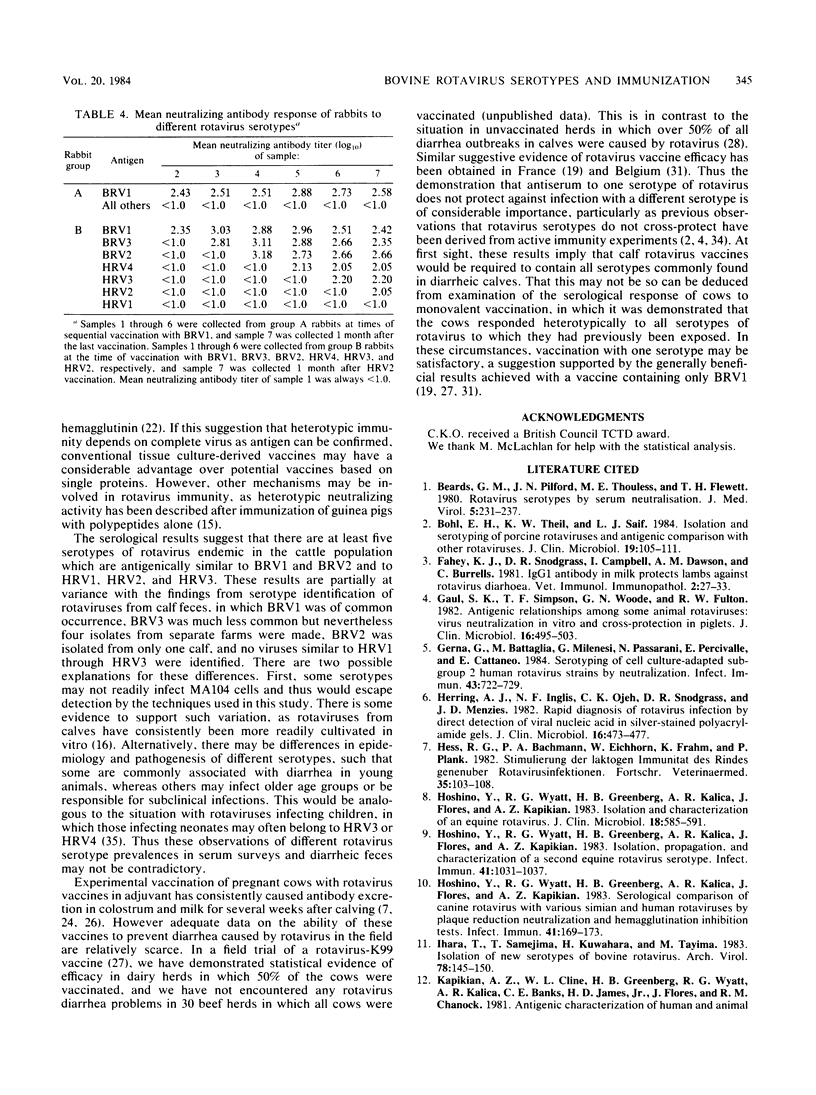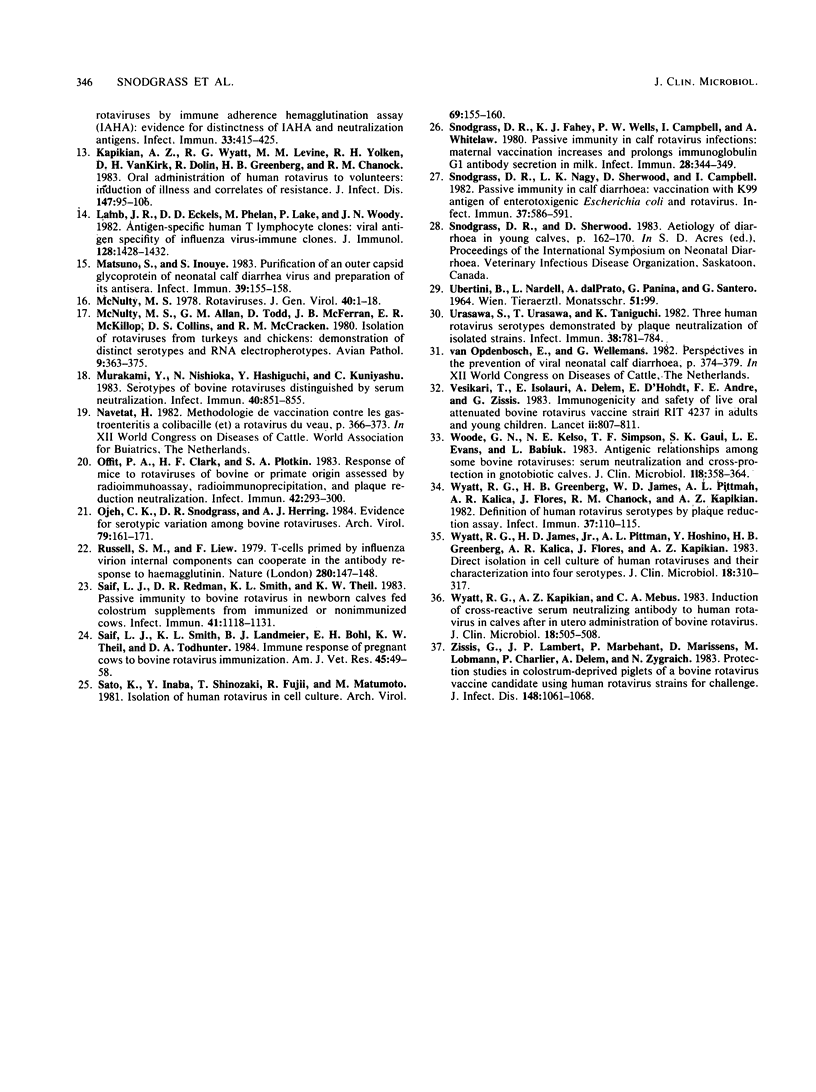Abstract
Neutralization assays on calf fecal rotavirus with antisera to two previously described bovine rotavirus serotypes allowed the isolation of four rotaviruses belonging to a distinct third serotype. In a survey of 85 calf isolates, 80 rotaviruses belonged to serotype 1 (91%), 1 belonged to serotype 2 (1%), and 4 belonged to serotype 3 (5%). Serotypes 1 and 2 were shown to not cross-protect in a passive immunization experiment in gnotobiotic lambs. Ingestion of specific antiserum protected against infection with the homologous, but not heterologous, serotype. Rabbits with no previous exposure to rotavirus responded to sequential vaccination with bovine and human rotavirus serotypes with antibody specific to those serotypes, and the response did not broaden to include serotypes to which they had not been exposed. These factors suggested the need for multivalent rotavirus vaccines. By contrast, 47 adult cows on 11 farms had neutralizing antibodies to two bovine and three human rotavirus serotypes. After vaccination with one bovine rotavirus serotype, these cows produced a significant increase in antibody titers to these same five serotypes but not to two other serotypes to which they had no preexisting antibody. These results were interpreted to indicate that cows will respond heterotypically after monovalent vaccination to all rotavirus serotypes with which they have had experience and, therefore, that single serotype vaccination may be sufficient. This conclusion has practical importance for rotavirus immunization procedures.
Full text
PDF




Selected References
These references are in PubMed. This may not be the complete list of references from this article.
- Beards G. M., Pilfold J. N., Thouless M. E., Flewett T. H. Rotavirus serotypes by serum neutralisation. J Med Virol. 1980;5(3):231–237. doi: 10.1002/jmv.1890050307. [DOI] [PubMed] [Google Scholar]
- Bohl E. H., Theil K. W., Saif L. J. Isolation and serotyping of porcine rotaviruses and antigenic comparison with other rotaviruses. J Clin Microbiol. 1984 Feb;19(2):105–111. doi: 10.1128/jcm.19.2.105-111.1984. [DOI] [PMC free article] [PubMed] [Google Scholar]
- Fahey K. J., Snodgrass D. R., Campbell I., Dawson A. M., Burrells C. IgG1 antibody in milk protects lambs against rotavirus diarrhoea. Vet Immunol Immunopathol. 1981 Feb;2(1):27–33. doi: 10.1016/0165-2427(81)90036-2. [DOI] [PubMed] [Google Scholar]
- Gaul S. K., Simpson T. F., Woode G. N., Fulton R. W. Antigenic relationships among some animal rotaviruses: virus neutralization in vitro and cross-protection in piglets. J Clin Microbiol. 1982 Sep;16(3):495–503. doi: 10.1128/jcm.16.3.495-503.1982. [DOI] [PMC free article] [PubMed] [Google Scholar]
- Gerna G., Battaglia M., Milenesi G., Passarani N., Percivalle E., Cattaneo E. Serotyping of cell culture-adapted subgroup 2 human rotavirus strains by neutralization. Infect Immun. 1984 Feb;43(2):722–729. doi: 10.1128/iai.43.2.722-729.1984. [DOI] [PMC free article] [PubMed] [Google Scholar]
- Herring A. J., Inglis N. F., Ojeh C. K., Snodgrass D. R., Menzies J. D. Rapid diagnosis of rotavirus infection by direct detection of viral nucleic acid in silver-stained polyacrylamide gels. J Clin Microbiol. 1982 Sep;16(3):473–477. doi: 10.1128/jcm.16.3.473-477.1982. [DOI] [PMC free article] [PubMed] [Google Scholar]
- Hoshino Y., Wyatt R. G., Greenberg H. B., Kalica A. R., Flores J., Kapikian A. Z. Isolation and characterization of an equine rotavirus. J Clin Microbiol. 1983 Sep;18(3):585–591. doi: 10.1128/jcm.18.3.585-591.1983. [DOI] [PMC free article] [PubMed] [Google Scholar]
- Hoshino Y., Wyatt R. G., Greenberg H. B., Kalica A. R., Flores J., Kapikian A. Z. Isolation, propagation, and characterization of a second equine rotavirus serotype. Infect Immun. 1983 Sep;41(3):1031–1037. doi: 10.1128/iai.41.3.1031-1037.1983. [DOI] [PMC free article] [PubMed] [Google Scholar]
- Hoshino Y., Wyatt R. G., Greenberg H. B., Kalica A. R., Flores J., Kapikian A. Z. Serological comparison of canine rotavirus with various simian and human rotaviruses by plaque reduction neutralization and hemagglutination inhibition tests. Infect Immun. 1983 Jul;41(1):169–173. doi: 10.1128/iai.41.1.169-173.1983. [DOI] [PMC free article] [PubMed] [Google Scholar]
- Ihara T., Samejima T., Kuwahara H., Tajima M. Isolation of new serotypes of bovine rotavirus. Brief report. Arch Virol. 1983;78(1-2):145–150. doi: 10.1007/BF01310870. [DOI] [PubMed] [Google Scholar]
- Kapikian A. Z., Wyatt R. G., Levine M. M., Yolken R. H., VanKirk D. H., Dolin R., Greenberg H. B., Chanock R. M. Oral administration of human rotavirus to volunteers: induction of illness and correlates of resistance. J Infect Dis. 1983 Jan;147(1):95–106. doi: 10.1093/infdis/147.1.95. [DOI] [PubMed] [Google Scholar]
- Lamb J. R., Eckels D. D., Phelan M., Lake P., Woody J. N. Antigen-specific human T lymphocyte clones: viral antigen specificity of influenza virus-immune clones. J Immunol. 1982 Mar;128(3):1428–1432. [PubMed] [Google Scholar]
- Matsuno S., Inouye S. Purification of an outer capsid glycoprotein of neonatal calf diarrhea virus and preparation of its antisera. Infect Immun. 1983 Jan;39(1):155–158. doi: 10.1128/iai.39.1.155-158.1983. [DOI] [PMC free article] [PubMed] [Google Scholar]
- McNulty M. S. Rotaviruses. J Gen Virol. 1978 Jul;40(1):1–18. doi: 10.1099/0022-1317-40-1-1. [DOI] [PubMed] [Google Scholar]
- Murakami Y., Nishioka N., Hashiguchi Y., Kuniyasu C. Serotypes of bovine rotaviruses distinguished by serum neutralization. Infect Immun. 1983 Jun;40(3):851–855. doi: 10.1128/iai.40.3.851-855.1983. [DOI] [PMC free article] [PubMed] [Google Scholar]
- Offit P. A., Clark H. F., Plotkin S. A. Response of mice to rotaviruses of bovine or primate origin assessed by radioimmunoassay, radioimmunoprecipitation, and plaque reduction neutralization. Infect Immun. 1983 Oct;42(1):293–300. doi: 10.1128/iai.42.1.293-300.1983. [DOI] [PMC free article] [PubMed] [Google Scholar]
- Ojeh C. K., Snodgrass D. R., Herring A. J. Evidence for serotypic variation among bovine rotaviruses. Arch Virol. 1984;79(3-4):161–171. doi: 10.1007/BF01310809. [DOI] [PubMed] [Google Scholar]
- Russell S. M., Liew F. Y. T cells primed by influenza virion internal components can cooperate in the antibody response to haemagglutinin. Nature. 1979 Jul 12;280(5718):147–148. doi: 10.1038/280147a0. [DOI] [PubMed] [Google Scholar]
- Saif L. J., Redman D. R., Smith K. L., Theil K. W. Passive immunity to bovine rotavirus in newborn calves fed colostrum supplements from immunized or nonimmunized cows. Infect Immun. 1983 Sep;41(3):1118–1131. doi: 10.1128/iai.41.3.1118-1131.1983. [DOI] [PMC free article] [PubMed] [Google Scholar]
- Saif L. J., Smith K. L., Landmeier B. J., Bohl E. H., Theil K. W., Todhunter D. A. Immune response of pregnant cows to bovine rotavirus immunization. Am J Vet Res. 1984 Jan;45(1):49–58. [PubMed] [Google Scholar]
- Sato K., Inaba Y., Shinozaki T., Fujii R., Matumoto M. Isolation of human rotavirus in cell cultures: brief report. Arch Virol. 1981;69(2):155–160. doi: 10.1007/BF01315159. [DOI] [PubMed] [Google Scholar]
- Snodgrass D. R., Fahey K. J., Wells P. W., Campbell I., Whitelaw A. Passive immunity in calf rotavirus infections: maternal vaccination increases and prolongs immunoglobulin G1 antibody secretion in milk. Infect Immun. 1980 May;28(2):344–349. doi: 10.1128/iai.28.2.344-349.1980. [DOI] [PMC free article] [PubMed] [Google Scholar]
- Snodgrass D. R., Nagy L. K., Sherwood D., Campbell I. Passive immunity in calf diarrhea: vaccination with K99 antigen of enterotoxigenic Escherichia coli and rotavirus. Infect Immun. 1982 Aug;37(2):586–591. doi: 10.1128/iai.37.2.586-591.1982. [DOI] [PMC free article] [PubMed] [Google Scholar]
- Urasawa S., Urasawa T., Taniguchi K. Three human rotavirus serotypes demonstrated by plaque neutralization of isolated strains. Infect Immun. 1982 Nov;38(2):781–784. doi: 10.1128/iai.38.2.781-784.1982. [DOI] [PMC free article] [PubMed] [Google Scholar]
- Vesikari T., Isolauri E., Delem A., D'Hondt E., André F. E., Zissis G. Immunogenicity and safety of live oral attenuated bovine rotavirus vaccine strain RIT 4237 in adults and young children. Lancet. 1983 Oct 8;2(8354):807–811. doi: 10.1016/s0140-6736(83)90734-1. [DOI] [PubMed] [Google Scholar]
- Woode G. N., Kelso N. E., Simpson T. F., Gaul S. K., Evans L. E., Babiuk L. Antigenic relationships among some bovine rotaviruses: serum neutralization and cross-protection in gnotobiotic calves. J Clin Microbiol. 1983 Aug;18(2):358–364. doi: 10.1128/jcm.18.2.358-364.1983. [DOI] [PMC free article] [PubMed] [Google Scholar]
- Wyatt R. G., Greenberg H. B., James W. D., Pittman A. L., Kalica A. R., Flores J., Chanock R. M., Kapikian A. Z. Definition of human rotavirus serotypes by plaque reduction assay. Infect Immun. 1982 Jul;37(1):110–115. doi: 10.1128/iai.37.1.110-115.1982. [DOI] [PMC free article] [PubMed] [Google Scholar]
- Wyatt R. G., James H. D., Jr, Pittman A. L., Hoshino Y., Greenberg H. B., Kalica A. R., Flores J., Kapikian A. Z. Direct isolation in cell culture of human rotaviruses and their characterization into four serotypes. J Clin Microbiol. 1983 Aug;18(2):310–317. doi: 10.1128/jcm.18.2.310-317.1983. [DOI] [PMC free article] [PubMed] [Google Scholar]
- Wyatt R. G., Kapikian A. Z., Mebus C. A. Induction of cross-reactive serum neutralizing antibody to human rotavirus in calves after in utero administration of bovine rotavirus. J Clin Microbiol. 1983 Sep;18(3):505–508. doi: 10.1128/jcm.18.3.505-508.1983. [DOI] [PMC free article] [PubMed] [Google Scholar]
- Zissis G., Lambert J. P., Marbehant P., Marissens D., Lobmann M., Charlier P., Delem A., Zygraich N. Protection studies in colostrum-deprived piglets of a bovine rotavirus vaccine candidate using human rotavirus strains for challenge. J Infect Dis. 1983 Dec;148(6):1061–1068. doi: 10.1093/infdis/148.6.1061. [DOI] [PubMed] [Google Scholar]


